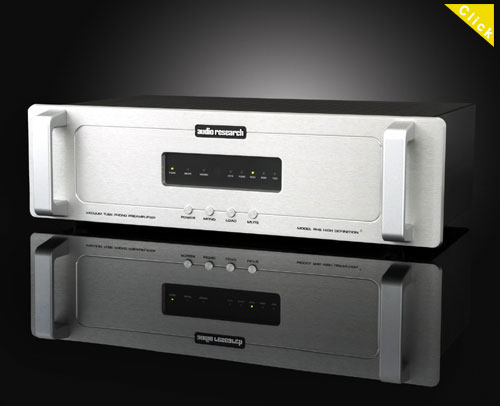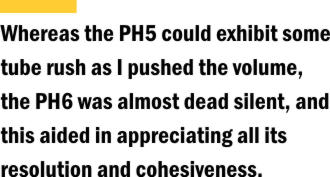Audio Research • PH6 Phono Stage
he phono stage was once a necessary and integral part of whatever preamp, integrated amp or receiver an audiophile contemplated purchasing. Back then, a turntable was the main source for listening to music, but around the mid-1980s, when the CD began to erode the dominance of the LP as the go-to music format, manufacturers began to eliminate the internal phono stage, and the standalone phono stage was, if not born, then fully developed. Audio Research was one of the companies that decided removing the phono stage from its preamplifiers would allow the creation of a higher-quality line stage in the same chassis and for the same price. But Audio Research never forgot that the phono stage remained a vital part of many audiophiles’ systems -- just as the company never forgot that tubes were important to better sound. Beginning with the MCP-2 in 1982 and moving down through the various PH iterations -- from the PH1 to the brand-new PH6 under discussion here -- Audio Research has always considered the phono stage a large part of its more affordable equipment offerings.
But what makes the PH6 special enough to cause Audio Research to scrap the highly praised PH5? The PH6 looks very much like its predecessor, although its front panel is a bit more rounded, which gives it a more pleasing look. Instead of an all-black touch panel below the indicator display, it uses a set of four silver aluminum buttons set into its faceplate for Power, Mono, Load (with five choices: 100, 200, 500, 1000, and 47k ohms), and Mute. It also comes with a remote that controls all these functions, so you can experiment -- especially with loading -- without leaving your seat. The PH6 offers 58dB of gain, which, together with the gain of your preamp, should be enough even with low-output moving-coil cartridges. The biggest change in the PH6 is internal. The PH5 used a hybrid circuit that employed both solid-state and tube gain stages. The input stage used a low-noise JFET section, while the RIAA equalization and gain stages used four 6922EH tubes -- and no step-up transformers. The PH6 uses the same hybrid circuit and JFET section, and eschews step-ups, but it replaces the 6922EH tubes with two 6H30s in its gain and output stages. I asked Dave Gordon of Audio Research why the company made the tube change, and he told me that it was part of a change to the 6H30 across the board as the company's tube of choice, because the 6H30 is a more dynamic, higher-resolution tube. It’s also a higher-current tube, which may be part of the reason for improved dynamics and greater resolving power. Mostly Dave said that the engineers and listeners at Audio Research think that while the 6922 is a fine tube, the 6H30 is a better one. I can also imagine that designing and building around a single tube allows for some cost savings that are either passed on or allow for better parts to be used elsewhere in the product. he very first thing I noticed after adding the PH6 to my system was how much of the music it passed on. There was abundant texture to every instrument and voice, along with a noticeable sense of acoustic space surrounding each -- and all before I had given the PH6 much break-in. It kept improving over the listening period. There wasn’t any one thing the PH6 did that stood out and shouted "This is why I was made" as much as simply presenting an overwhelming sense of more, along with a corresponding sense of less being in the way. To use that hackneyed expression, it was as if a window between stereo system and listener had been given a thorough cleaning. Dead Can Dance's music is both complicated and detailed. Into the Labyrinth [Mobile Fidelity MOFI 2-001] has a sense of atmosphere and space to create the proper mood. Thanks to the PH6's low noise floor, not only was the instrumentation allowed to flourish, but that sense of atmosphere came to be a part of the musical presentation. The PH6 did so without making it seem artificially injected -- it was just a natural part of listening to this LP. One of my favorite review LPs -- okay, one of my favorite LPs, period -- is Dave Bailey’s One Foot in the Gutter [Epic/Classic BA 17008]. Over and above the superb music is its studio sound, which, when properly reproduced, can make you feel as if you’re in the studio with Bailey, Junior Cook, Clark Terry and the rest. The PH6 not only gave me that sensation, it added a dose of reality by retrieving copious detail, such as the snap of Bailey’s sticks on the drum head or cymbal. Terry’s flugelhorn had a bit more of the brassy blat that makes it sound like the real thing, giving the opportunity to suspend disbelief for a few breathtaking moments. The PH6 gave me many such moments as I listened to albums front to back.
Another thing I’ve come to expect from the better phono stages is cohesiveness -- the ability to keep the music together and flowing, not parse it into individual "events." The PH6 is a cohesiveness champ. Mark Knopfler’s guitar on Kill To Get Crimson [Warner Brothers 281660-1] is a case in point. As Knopfler has grown older, he has mastered the art of conveying a great deal through very few notes. However, if a phono stage can’t keep those notes flowing properly, the meaning of the music is lost. The PH6 flowed along with Knopfler, creating a stream of varying textures -- just what Knopfler does as well. Going hand in hand with cohesiveness is resolution. Having only one of these is like having peanut butter or jelly. Individually they may be nice, but combined they create something special. The PH6 has cohesiveness and resolution in spades. I discovered this by listening to the latest Pure Pleasure reissue of the self-titled Quicksilver Messenger Service LP [Pure Pleasure PPAN ST2904]. Guitarist John Cipollina was in the room so clearly and with such substance that I could hear each pluck or strum and, just as important, how each coalesced into the body of each solo --- especially on the opening track, "Pride Of A Man," which has one of the best guitar solos I’ve ever heard. Vocals were another strong point of the PH6, which allowed me to hear better the identifying marks of various singers. The slightly nasal but oh-so-smooth quality of Art Garfunkel’s voice on Watermark [Columbia JC 34975] was all the more apparent, and Shawn Philips' voice on his album Second Contribution [A&M SP 4282] was full, deep and rich. The PH6 easily differentiated between these two male singers, allowing each to sound like himself with no super-imposed colorations tacked on. In the end, the PH6 let records sound just as they're supposed to, and that's a great thing from the perspective of this hardcore vinylphile.
e audiophiles often wonder why a certain company
replaces a very good piece of equipment. Oftentimes it can be as simple as wanting to
freshen up in the product line. Audio Research released the PH6, however, because it
betters in every way the model it replaces. It is simply a cleaner window between you and
your music and, I'll go out on a limb, the phono stage to beat in its price range. Its
sterling sound quality together with its excellent build quality, Audio Research’s
reputation and the knowledge that they’ll be around to care for the product well into
the future means that purchasing a PH6 can be one of the best investments in your musical
life you can make.
|


 Bass, a bane of most tube equipment,
was outstanding. The PH6 fleshed out the lowest frequencies and gave everything room to
breathe -- as a big instrument like an upright acoustic bass should have. I adored the way
Ray Brown’s playing sounded as I listened to Soular Energy [Concord/Pure
Audiophile PR-065]. The bass was appropriately woody and more than deep enough (and my
Paradigm speakers can go plenty deep) to satisfy even the pickiest of listeners. But more
than that, it was the feeling of realness that the PH6 imparted that tipped the scales in
its favor over any solid-state unit I’ve heard -- and any phono stage I've heard in
the PH6’s price range.
Bass, a bane of most tube equipment,
was outstanding. The PH6 fleshed out the lowest frequencies and gave everything room to
breathe -- as a big instrument like an upright acoustic bass should have. I adored the way
Ray Brown’s playing sounded as I listened to Soular Energy [Concord/Pure
Audiophile PR-065]. The bass was appropriately woody and more than deep enough (and my
Paradigm speakers can go plenty deep) to satisfy even the pickiest of listeners. But more
than that, it was the feeling of realness that the PH6 imparted that tipped the scales in
its favor over any solid-state unit I’ve heard -- and any phono stage I've heard in
the PH6’s price range. ompared to my longtime
reference, the Audio Research PH5 ($2995), each musical aspect of the PH6 was just that
much better. If the PH5 was very good at something -- like differentiating voices -- the
PH6 exceeded it. The PH5 improved upon its newer sibling in no discernible way; believe
me, I tried to find something, anything, to point out, but couldn't. The use of the
6H30 tubes makes for a noticeable improvement in dynamic shading and the depth of
soundstage that the PH5, good as it is, can’t match. There was one area in particular
in which the PH6 was noticeably better than its older brother -- the noise floor. Whereas
the PH5 could exhibit some tube rush as I pushed the volume, the PH6 was almost dead
silent, and this aided in appreciating all its resolution and cohesiveness. Don’t get
me wrong -- the PH5 is still a very good phono stage. It’s just that the PH6 is a
better one.
ompared to my longtime
reference, the Audio Research PH5 ($2995), each musical aspect of the PH6 was just that
much better. If the PH5 was very good at something -- like differentiating voices -- the
PH6 exceeded it. The PH5 improved upon its newer sibling in no discernible way; believe
me, I tried to find something, anything, to point out, but couldn't. The use of the
6H30 tubes makes for a noticeable improvement in dynamic shading and the depth of
soundstage that the PH5, good as it is, can’t match. There was one area in particular
in which the PH6 was noticeably better than its older brother -- the noise floor. Whereas
the PH5 could exhibit some tube rush as I pushed the volume, the PH6 was almost dead
silent, and this aided in appreciating all its resolution and cohesiveness. Don’t get
me wrong -- the PH5 is still a very good phono stage. It’s just that the PH6 is a
better one.